In Part 1 of this article, I discussed how to set up a temporary spray finishing area in your shop. For those who want to take the next step, in today’s video (above) I’ll show you a few ways to make a wood finishing spray booth for your shop.
Keep in mind, these are four examples of basic booths that can be permanent or “fold away” designs that can be set up and broken down as-needed.
Please also note they will not be “explosion proof” and therefore not “certifiable” from a safety standpoint, but they are all very efficient and function just fine for spraying water based finishes.
And speaking of safety, it’s worth repeating the cardinal rules you must follow.
Please Note: despite the safety measures mentioned below, the process described here could be dangerous and is therefore intended for informational purposes only and for people having appropriate technical knowledge, experience, and skill to consider and use at their own discretion and risk.
CARDINAL RULES
There are three rules you must follow:
1. Turn off Air-handling Systems Fans. While actively spraying, turn off the fans on any air conditioning/heating systems that circulate air within and into your shop. This will keep any overspray (yes even HVLP systems generate a certain amount) from clogging filters and/or possibly causing problems with these systems.
2. Only Spray Water Based Products. It can’t be emphasized enough that the procedures described here are only to be used for spraying non-flammable products. If you’re planning to spray anything else indoors, a certified spray booth that meets the applicable local codes is required.
3. Wear a Respirator. Get yourself a well-fitting respirator that protects against organic vapors and wear it every time you’re spraying. Yes, even if only doing a quick touch-up. Keep others (pets, too) out of the shop when spraying is in operation, or ensure they’re also wearing respirators.
WOOD FINISHING SPRAY BOOTHS YOU CAN MAKE (4 Examples)
You will see more details by watching the video above, so I’ll simply summarize the four examples here:
Example 1: Stowable 3-Panel Spray Booth
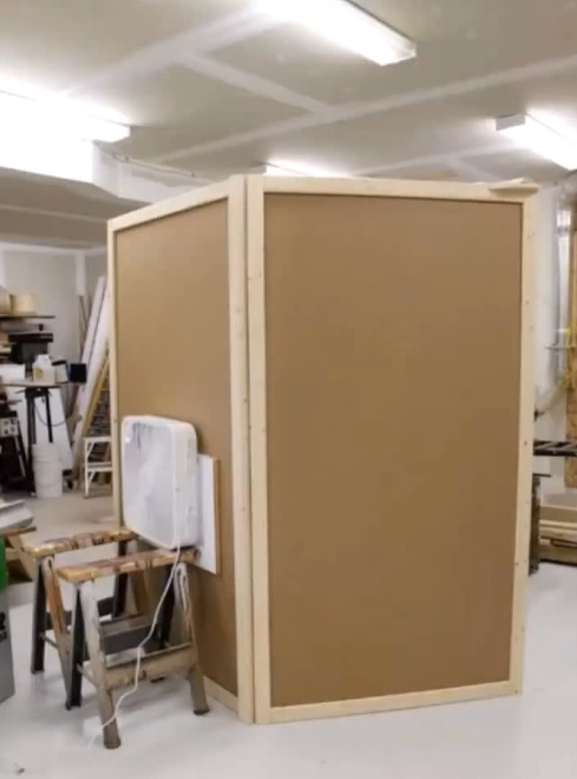
Each of the three panels are hinged together and fold for stowing away.
As you can see above, this model has a simple window box fan and a furnace filter, mounted on sawhorses.
Example 2: David Bedrosian’s Foldup Garage Booth
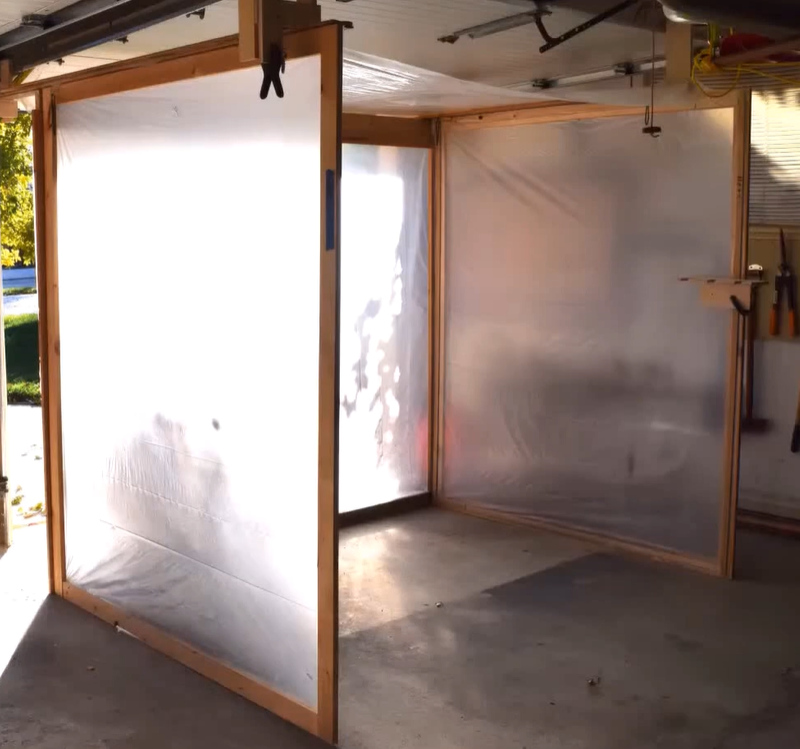
This booth literally folds “up.” As you’ll see in the video, the panels fold up and are stored just below the garage ceiling.
The other nice part about this garage booth is, the fan vents directly to the outside.
Example 3: Karen McBride’s Stowable, Curtain-Sided Spray Booth
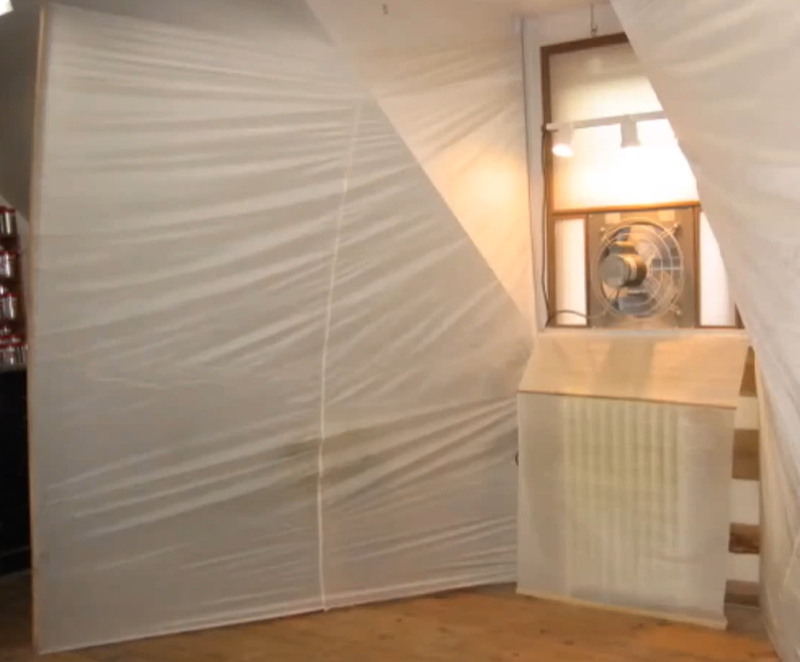
The fan you see above is affixed to a hinged panel that swings down in front of the window when it’s time to spray.
Each curtain is attached to support poles that sit into shallow holes/notches in the floor, keeping them secure.
Then, good ‘ol bungee cords are used as extra support and to help hold the curtain frames in place.
Example 4: Marty’s Wall-Mounted Folding Spray Booth
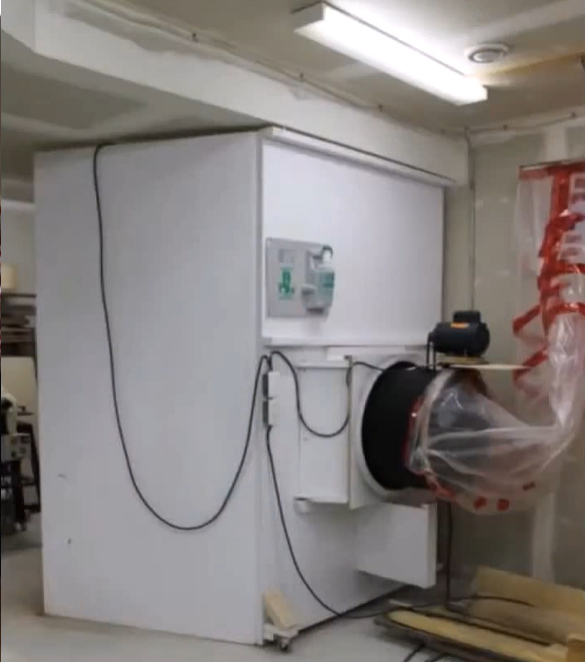
This was my old, wall-mounted spray booth consisting of wooden, hinged panels with wheels on the bottom so the panels could be easily swung out (and back in).
I connected the plastic tubing on the back of the fan to vent fumes out a window.
Again, I highly recommend watching the above video to see what these spray booths look like from more angles. It will make it much easier if you decide to make a wood finishing spray booth of your own.
If you have questions, comments, or want to share your experiences with setting up a temporary spray finishing area — or making a wood finishing spray booth — please post your thoughts in the comments section below. I’ll respond to as many as I can.

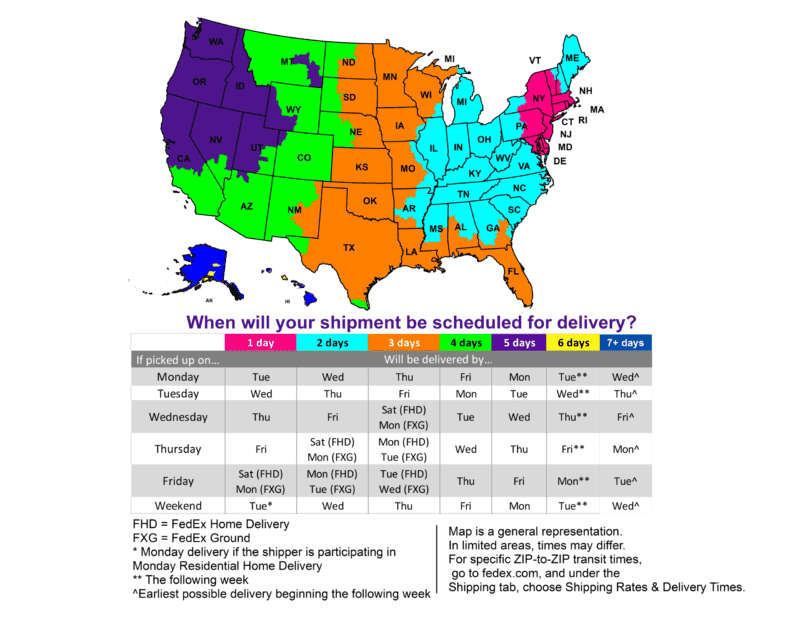
Homemade spray booths should include filters to capture exhausted finish particulate. Even HVLP turbine sprayers produce airborne particles that get drawn outside by the fan. A box frame that holds a few inexpensive furnace filters positioned on the exhaust side of the fan is effective .
Looking at example 1, my question is: does this not need to exhaust to the outside through an opening such as a window? I also notice in all three examples that none of them are fully enclosed. Does this not cause large amounts of overspray in the shop?
From Marty Schlosser, who is away on assignment, we received this reply:
Thanks for your comments, Bryan. It’s always great hearing from my readers.
You’re correct in stating that the first example doesn’t exhaust to the outside. This example was provided for those who aren’t spraying often enough to warrant investing in a full-featured booth. Given today’s true HVLP systems with their minimal overspray, this option should suffice for these situations. And because HVLP the fan draws away any overspray where most of it can be captured in the filter, by covering tools and workspaces downstream of the airflow, there shouldn’t be much, if any overspray to contend with. I know of several small pro shops who operate on this manner, and although it’s not ideal, it meets their needs.
Fully enclosed booths are seldom seen in smaller shops because they require more than triple the footprint of open-faced booths. Again, it will depend on the volume of spray finishing being undertaken in the shop. In a perfect world, enclosed booths with pre-filtering and air conditioning systems to ensure a pristine spraying environment, coupled with a pro-grade exhaust handling system, would be ideal… but is something that only high volume finishing shops can realistically afford.
Again, thanks for your comments, Bryan.